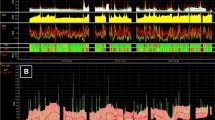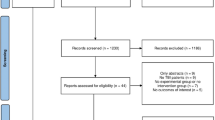Abstract
Objective
To compare the effects of a cerebral perfusion pressure (CPP) intervention achieved with dopamine and norepinephrine after severe head injury.
Design
Prospective, controlled, trial.
Setting
Neurosciences critical care unit.
Patients
Eleven patients with a head injury, requiring dopamine or norepinephrine infusions to support CPP.
Intervention
Cerebral tissue gas measurements were recorded using a multimodal sensor, and regional chemistry was assessed using microdialysis. Patients received in, randomised order, either dopamine or norepinephrine to achieve and maintain a CPP of 65 mmHg, and then, following a 30-min period of stable haemodynamics, a CPP of 85 mmHg. Data were then acquired using the second agent. Haemodynamic measurements and measurements of cerebral physiology were made during each period.
Measurements and results
The CPP augmentation with norepinephrine, but not with dopamine, resulted in a significant reduction in arterial–venous oxygen difference (37±11 vs 33±12 ml/l) and a significant increase in brain tissue oxygen (2.6±1.1 vs 3.0±1.1 kPa). The CPP intervention did not significantly affect intracranial pressure. There were no significant differences between norepinephrine and dopamine on cerebral oxygenation or metabolism either at baseline or following a CPP intervention; however, the response to a CPP intervention with dopamine seemed to be more variable than the response achieved with norepinephrine.
Conclusions
If CPP is to be raised to a level higher than 65–70 mmHg, then it is important to recognise that the response to the intervention may be unpredictable and that the vasoactive agent used may be of importance.


Similar content being viewed by others
References
The Brain Trauma Foundation (2000) The American Association of Neurological Surgeons. The Joint Section on Neurotrauma and Critical Care. Guidelines for cerebral perfusion pressure. J Neurotrauma 17:507–511
Changaris DG, McGraw CP, Richardson JD, Garretson HD, Arpin EJ, Shields CB (1987) Correlation of cerebral perfusion pressure and Glasgow Coma Scale to outcome. J Trauma 27:1007–1013
Rosner MJ, Rosner SD, Johnson AH (1995) Cerebral perfusion pressure: management protocol and clinical results. J Neurosurg 83:949–962
Stocchetti N, Chieregato A, Marchi M de, Croci M, Benti R, Grimoldi N (1998) High cerebral perfusion pressure improves low values of local brain tissue O2 tension (PtiO2) in focal lesions. Acta Neurochir Suppl 71:162–165
Asgeirsson B, Grande PO, Nordstrom CH (1994) A new therapy of post-trauma brain oedema based on haemodynamic principles for brain volume regulation. Intensive Care Med 20:260–267
Robertson CS, Valadka AB, Hannay HJ, Contant CF, Gopinath SP, Cormio M, Uzura M, Grossman RG (1999) Prevention of secondary ischemic insults after severe head injury. Crit Care Med 27:2086–2095
Edvinsson L, Krause DN (2002) Catecholamines. In: Edvinsson L, Krause DN (eds) Cerebral blood flow and metabolsim. Lippincott, Williams and Wilkins, Philadelphia
Altura BM, Gebrewold A, Lassoff S (1980) Biphasic responsiveness of rat pial arterioles to dopamine: direct observations on the microcirculation. Br J Pharmacol 69:543–544
McCalden TA, Eidelman BH, Mendelow AD (1977) Barrier and uptake mechanisms in the cerebrovascular response to noradrenaline. Am J Physiol 233:H458–H465
Myburgh JA, Upton RN, Grant C, Martinez A (1998) A comparison of the effects of norepinephrine, epinephrine, and dopamine on cerebral blood flow and oxygen utilisation. Acta Neurochir Suppl 71:19–21
Kroppenstedt SN, Sakowitz OW, Thomale UW, Unterberg AW, Stover JF (2002) Norepinephrine is superior to dopamine in increasing cortical perfusion following controlled cortical impact injury in rats. Acta Neurochir Suppl 81:225–227
Kroppenstedt SN, Sakowitz OW, Thomale UW, Unterberg AW, Stover JF (2002) Influence of norepinephrine and dopamine on cortical perfusion, EEG activity, extracellular glutamate, and brain edema in rats after controlled cortical impact injury. J Neurotrauma 19:1421–1432
Tuor UI, Edvinsson L, McCulloch J (1986) Catecholamines and the relationship between cerebral blood flow and glucose use. Am J Physiol 251:H824–H833
Edvinsson L, Hardebo JE, MacKenzie ET, Owman C (1978) Effect of exogenous noradrenaline on local cerebral blood flow after osmotic opening of the blood-brain barrier in the rat. J Physiol 274:149–156
Ract C, Vigue B (2001) Comparison of the cerebral effects of dopamine and norepinephrine in severely head-injured patients. Intensive Care Med 27:101–106
Haitsma IK, Mass AI (2002) Advanced monitoring in the intensive care unit: brain tissue oxygen tension. Curr Opin Crit Care 8:115–120
Johnston AJ, Gupta AK (2002) Advanced monitoring in the neurology intensive care unit: microdialysis. Curr Opin Crit Care 8:121–127
Menon DK (1999) Cerebral protection in severe brain injury: physiological determinants of outcome and their optimisation. Br Med Bull 55:226–258
Patel HC, Menon DK, Tebbs S, Hawker R, Hutchinson PJ, Kirkpatrick PJ (2002) Specialist neurocritical care and outcome from head injury. Intensive Care Med 28:547–553
Hutchinson PJ, Hutchinson DB, Barr RH, Burgess F, Kirkpatrick PJ, Pickard JD (2000) A new cranial access device for cerebral monitoring. Br J Neurosurg 14:46–48
Menzel M, Doppenberg EM, Zauner A, Soukup J, Reinert MM, Clausen T, Brockenbrough PB, Bullock R (1999) Cerebral oxygenation in patients after severe head injury: monitoring and effects of arterial hyperoxia on cerebral blood flow, metabolism and intracranial pressure. J Neurosurg Anesthesiol 11:240–251
van Santbrink H, Maas AI, Avezaat CJ (1996) Continuous monitoring of partial pressure of brain tissue oxygen in patients with severe head injury. Neurosurgery 38:21–31
Czosnyka M, Whitehouse H, Smielewski P, Kirkpatrick P, Guazzo EP, Pickard JD (1994) Computer supported multimodal bed-side monitoring for neuro intensive care. Int J Clin Monit Comput 11:223–232
Gupta AK, Hutchinson PJ, Al-Rawi P, Gupta S, Swart M, Kirkpatrick PJ, Menon DK, Datta AK (1999) Measuring brain tissue oxygenation compared with jugular venous oxygen saturation for monitoring cerebral oxygenation after traumatic brain injury. Anesth Analg 88:549–553
Stahl N, Ungerstedt U, Nordstrom CH (2001) Brain energy metabolism during controlled reduction of cerebral perfusion pressure in severe head injuries. Intensive Care Med 27:1215–1223
Grande PO, Moller AD, Nordstrom CH, Ungerstedt U (2000) Low-dose prostacyclin in treatment of severe brain trauma evaluated with microdialysis and jugular bulb oxygen measurements. Acta Anaesthesiol Scand 44:886–894
Acknowledgements
A. Johnston is supported by a grant from Codman. L. Steiner is supported by a Myron B. Laver Grant (Department of Anaesthesia, University of Basel, Switzerland) and grants from the Margarete und Walter Lichtenstein-Stiftung (Basel, Switzerland) and the Swiss National Science Foundation. He is recipient of an Overseas Research Student Award (Committee of Vice-Chancellors and Principals of the Universities of the United Kingdom). J. Coles is a Wellcome research training fellow. P. Al-Rawi is currently supported by a grant from the Stroke Association. Work of the department is supported by a grant from the Medical Research Council (grant no. G 9439390 ID56833).
Author information
Authors and Affiliations
Corresponding author
Rights and permissions
About this article
Cite this article
Johnston, A.J., Steiner, L.A., Chatfield, D.A. et al. Effect of cerebral perfusion pressure augmentation with dopamine and norepinephrine on global and focal brain oxygenation after traumatic brain injury. Intensive Care Med 30, 791–797 (2004). https://doi.org/10.1007/s00134-003-2155-7
Received:
Accepted:
Published:
Issue Date:
DOI: https://doi.org/10.1007/s00134-003-2155-7




